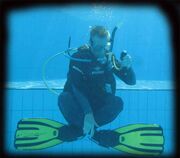To dive safely, divers must control their rate of descent and ascent in the water
and be able to maintain a constant depth in midwater. Ignoring other forces such as water currents and swimming, the diver's
buoyancy determines whether they ascend or descend. Equipment such as diving weighting systems, diving suits (wet, dry or semi-dry suits are used depending on the water temperature) and buoyancy compensators can be used to adjust the overall buoyancy. When divers want to remain at constant depth, they try to achieve neutral buoyancy. This minimizes the effort of swimming to maintain depth and reduces gas consumption caused.
Factors[]
Diving suits made of compressible materials decrease in volume as the diver descends, and expand again as the diver ascends, causing buoyancy changes. Diving in different environments also necessitates adjustments in the amount of weight carried to achieve neutral buoyancy. The diver can inject air into dry suits to counteract the compression effect and squeeze. Buoyancy compensators allow easy and fine adjustments in the diver's overall volume and therefore buoyancy. For open circuit divers, changes in the diver's average lung volume during a breathing cycle can be used to make fine adjustments of buoyancy.
Neutral buoyancy[]
Neutral buoyancy in a diver is an unstable state. It is changed by small differences in ambient pressure caused by a change in depth, and the change has a positive feedback effect. A small descent will increase the pressure, which will compress the gas filled spaces and reduce the total volume of diver and equipment. This will further reduce the buoyancy, and unless counteracted, will result in sinking more rapidly. The equivalent effect applies to a small ascent, which will trigger an increased buoyancy and will result in accelerated ascent unless counteracted. The diver must continuously adjust buoyancy or depth in order to remain neutral. This is a skill which improves with practice until it becomes second nature.
Importance of correct weighting[]
For each kilogram of excess weight that a diver carries, they must add a litre of free air to their bouyancy device near the surface. By the time they have descended to 10 metres they must have added another litre of free air per kg overweight to maintain neutral buoyancy because the ambient pressure increase has halved the volume and hence the lift of that air. This continues as the diver descends deeper. On ascent, that excess air has to be vented appropriately to avoid an uncontrolled ascent. A diver who is very overweighted will have a very uncomfortable dive because of the need to continually add air on descent and vent air on ascent as well as increased difficulty in achieving neutral bouyancy.
Setting correct weighting[]
To set the optimal weighting a diver needs to use only enough weight to be neutrally bouyant when just below the surface in full kit and an almost empty cylinder, with little or no air in their buoyancy device and drysuit, and with a comfortable amount of air in their lungs. That represents the most buoyant condition normally encountered and the amount of weight needed to achieve neutral buoyancy is the minimum weight needed at any stage on the dive. Since excess weight equates to greater instability, that weighting is therefore the optimal for that diver and gear configuration.